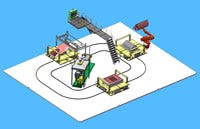Trolley takes the cut sheet out of cut-sheet thermoforming
Eliminating the need for ovens and the heating of sheet, a new thermoforming process directly extrudes plastic onto tooling for twin-sheet thermoforming. Bart Berghuis, VP of sales at LRM Industries International Inc. (Rockledge, FL), told MPW its TSD Twin Sheet Direct uses a profiled lay-down where molds are coated with molten thermoplastic material directly from extrusion.
July 25, 2009
Eliminating the need for ovens and the heating of sheet, a new thermoforming process directly extrudes plastic onto tooling for twin-sheet thermoforming. Bart Berghuis, VP of sales at LRM Industries International Inc. (Rockledge, FL), told MPW its TSD Twin Sheet Direct uses a profiled lay-down where molds are coated with molten thermoplastic material directly from extrusion. In addition to eliminating ovens, the automated system also does away with the stress and discrepancies in thickness that can result from reheating and forming sheet.
|
LRM says the process is an extension of its patent-pending STF Sheetless ThermoForming technology, which it commercialized in 2007. Berghuis adds that LRM’s process isn’t as limited as traditional thermoforming processes in terms of the materials it can run or the parts it can make. In the LRM system, computer-guided, wireless trolleys that are 10-ft wide and up to 20-ft long, run on a single track, with power coming through the rail and propelling the system. The trolley, which houses heating, cooling, and vacuum, carries large molds, which measure 50-60 inches wide by 50-60 inches high and up to 17-ft long, underneath a 6-inch extruder with a 10-ft wide web that “coats” the tool with molten plastic as they pass. Berghuis says the technology allows the melt coating the mold to be profiled, creating thicker or thinner sections as needed for deep-draw areas and the like. An automated device cuts the melt stream once the tool is covered, and the integrated cooling and vacuum start to form the part, with still warm parts joined with mating halves for twin-sheet hollow thermoformed components.
Berghuis says the company intends to sell licenses for the technology, and continues to run the existing system, which can accommodate five trolleys, making large parts like spas and bath tubs at its Florida site. In terms of materials, LRM has been able to run everything from highly-glass-filled material to recyclates, since web strength isn’t an issue.
Earlier in July, former LRM owners Nova Chemicals and Envirokare Tech Inc., which ran LRM as a joint venture since 2005, sold their interest in the business to a group of investors led by Zesiger Capital Group LLC. After being acquired by Kuwait’s IPIC, Nova is in the process of winding down JVs to focus on its core resin-making business. —[email protected]
About the Author(s)
You May Also Like



